Rare houseplants can transform an ordinary room into a stunning botanical sanctuary with their unique features and striking appearances. You’ll discover plants that range from the coveted Pink Princess Philodendron, with its splashes of rosy variegation, to the otherworldly Crystal Anthurium‘s translucent leaves. While some of these specimens require specialized care and can command premium prices, their extraordinary characteristics make them prized additions to any serious plant collector’s ensemble.

Contents
- 1 1. Pink Princess Philodendron
- 2 2. White Bird of Paradise
- 3 3. Watermelon Peperomia
- 4 4. String of Turtles
- 5 5. Variegated Monstera Deliciosa
- 6 6. Black Velvet Alocasia
- 7 8. Spiral Calathea Ornata
- 8 9. Ponytail Palm
- 9 10. Red Dragon Anthurium
- 10 11. Persian Shield Plant
- 11 13. Zebra Plant With Stripes
- 12 14. Crystal Anthurium
- 13 15. Ruby Rubber Tree
1. Pink Princess Philodendron
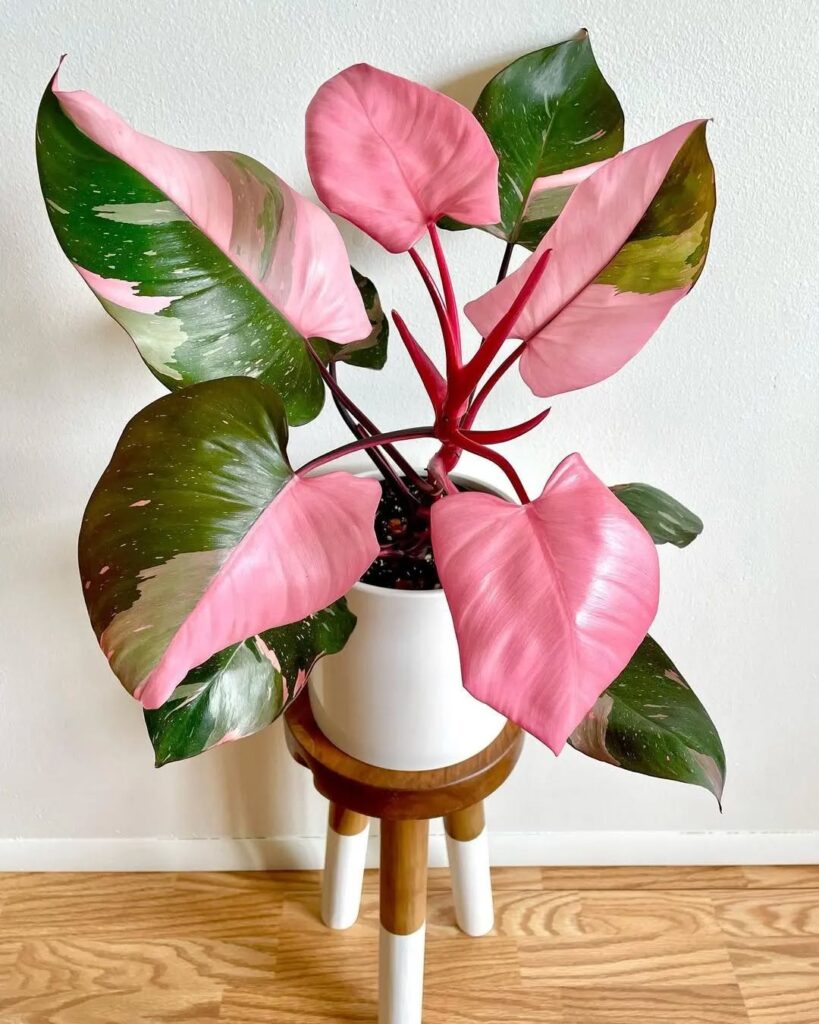
The Pink Princess Philodendron is a highly sought-after tropical plant known for its stunning dark green leaves with vibrant pink variegation. This climbing philodendron features heart-shaped foliage that can display varying amounts of pink coloring, making each leaf unique. The variegation is caused by a genetic mutation, and the amount of pink on each leaf can vary greatly. While beautiful, these plants are relatively slow-growing and require specific conditions to maintain their prized pink coloration.
- Light: Bright, indirect light; avoid direct sunlight which can burn leaves; too little light will reduce pink variegation
- Water: Allow top 1-2 inches of soil to dry between waterings; water less in winter
- Soil: Well-draining, rich aroid mix with orchid bark, perlite, and peat moss
- Humidity: 60% or higher; use humidifier or pebble tray if needed
- Temperature: 65-80°F (18-27°C); protect from cold drafts
- Fertilizer: Balanced liquid fertilizer monthly during growing season
- Support: Provide moss pole or trellis for climbing
- Pruning: Remove fully green leaves to encourage variegated growth
2. White Bird of Paradise
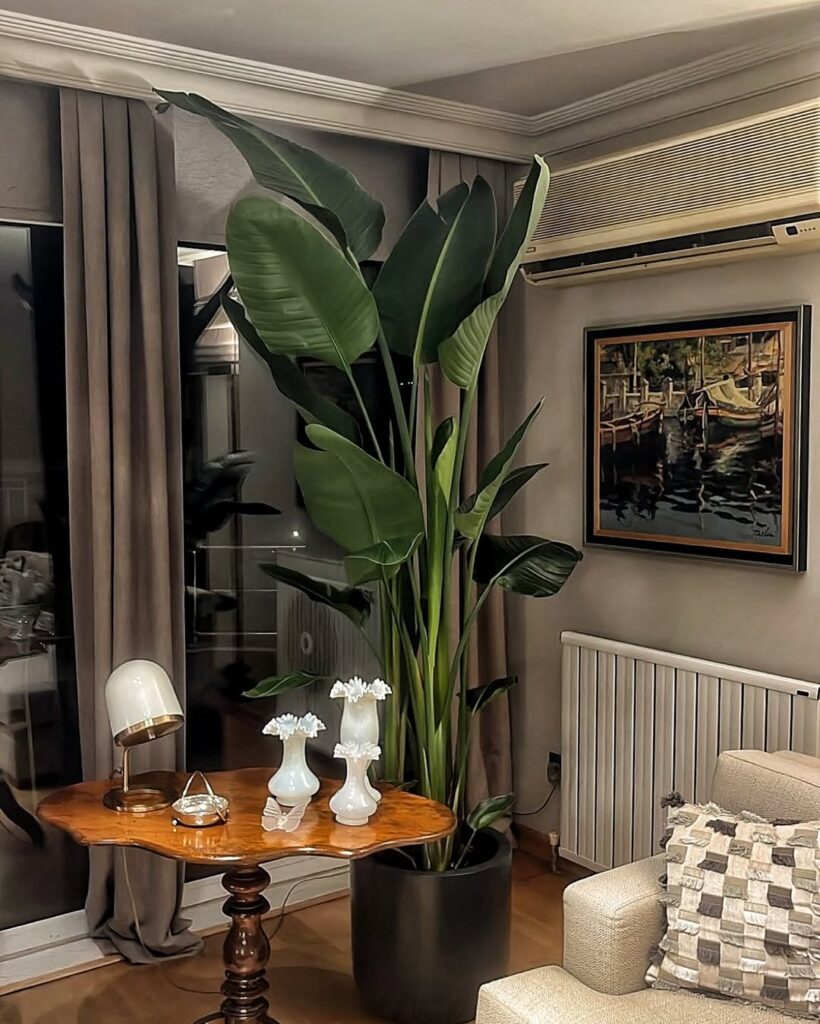
The White Bird of Paradise (Strelitzia nicolai) is a dramatic tropical plant known for its massive banana-like leaves that can grow up to 6-10 feet tall indoors. With proper care, this architectural beauty can become a striking focal point, featuring large paddled leaves that naturally split and create a fan-like appearance. While similar to its cousin Strelitzia reginae, the White Bird of Paradise is especially larger and produces white flowers instead of orange ones, though blooming is rare indoors.
- Light: Bright, indirect light; can tolerate some direct morning sun
- Water: Keep soil consistently moist but not waterlogged; water when top 2-3 inches of soil feels dry
- Soil: Well-draining, rich potting mix with added perlite
- Humidity: Prefers high humidity (50-60%)
- Temperature: 65-80°F (18-27°C)
- Fertilizer: Feed monthly during growing season with balanced fertilizer
- Container: Large pot with drainage holes; needs repotting every 2-3 years
- Space: Requires ample room for growth and spread
- Soil pH: 6.0-7.5
3. Watermelon Peperomia
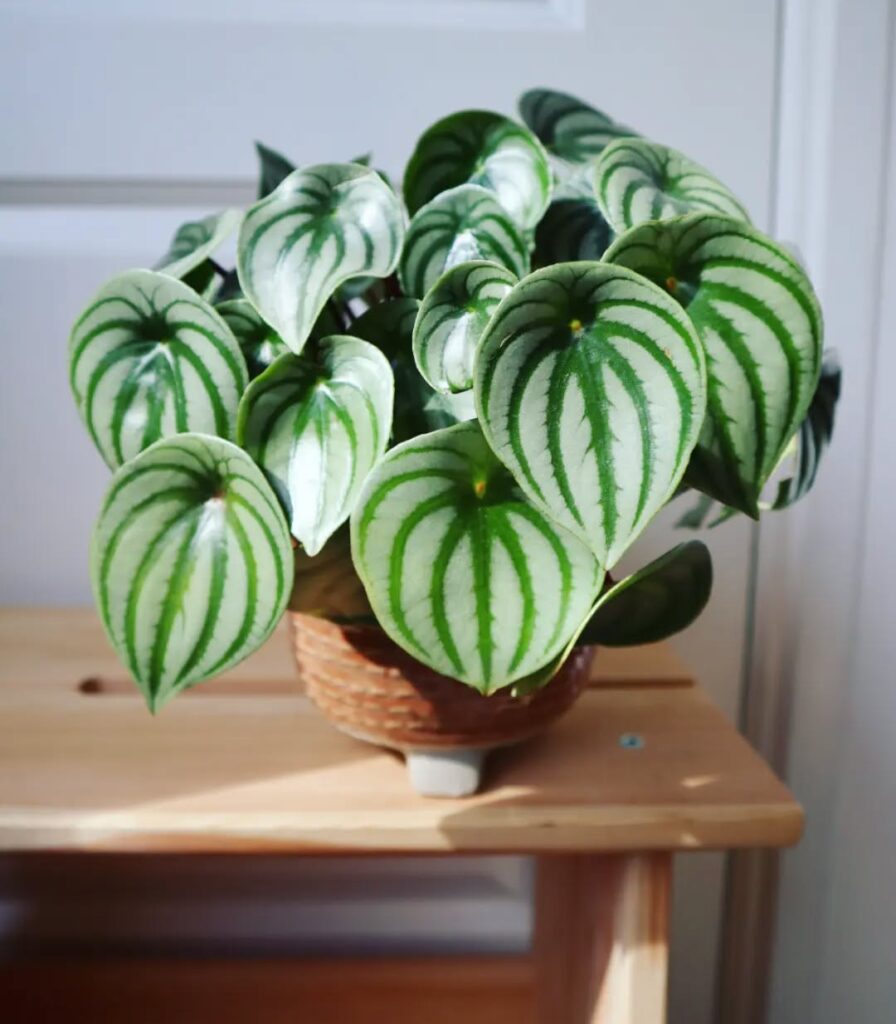
Watermelon Peperomia (Peperomia argyreia) is a charming tropical plant known for its distinctive oval leaves that resemble watermelon rinds, featuring silvery stripes on dark green surfaces. This compact plant, native to South America, typically grows to about 8 inches tall and makes an excellent houseplant due to its manageable size and striking ornamental value. The thick, fleshy leaves grow on red-tinged stems, creating an attractive display that adds visual interest to any indoor space.
- Light: Bright, indirect light; avoid direct sunlight which can scorch leaves
- Water: Allow top 1-2 inches of soil to dry between waterings; sensitive to overwatering
- Humidity: Moderate to high humidity (50-75%); benefits from occasional misting
- Temperature: 65-80°F (18-27°C)
- Soil: Well-draining potting mix; preferably a mixture of peat moss, perlite, and standard potting soil
- Fertilizer: Feed monthly with balanced, water-soluble fertilizer during growing season
- Container: Pot with drainage holes to prevent root rot
- Propagation: Easily propagated through leaf cuttings or stem cuttings
4. String of Turtles

The String of Turtles (Peperomia prostrata) is a delicate trailing plant known for its tiny, round leaves that feature intricate patterns resembling turtle shells. This compact succulent-like plant originates from Brazil and grows as a creeping vine, making it perfect for hanging baskets or as a tabletop accent. The leaves are typically dark green with silvery veining, creating a striking visual pattern that gives the plant its distinctive turtle shell appearance.
- Light: Bright indirect light; protect from direct sunlight
- Water: Allow top inch of soil to dry between waterings; reduce watering in winter
- Soil: Well-draining potting mix with perlite and orchid bark
- Humidity: Moderate to high (50-60%)
- Temperature: 65-75°F (18-24°C)
- Fertilizer: Light feeding with balanced fertilizer during growing season
- Potting: Small containers with drainage holes; can be grown in shallow pots
- Propagation: Easily propagated through stem cuttings
5. Variegated Monstera Deliciosa
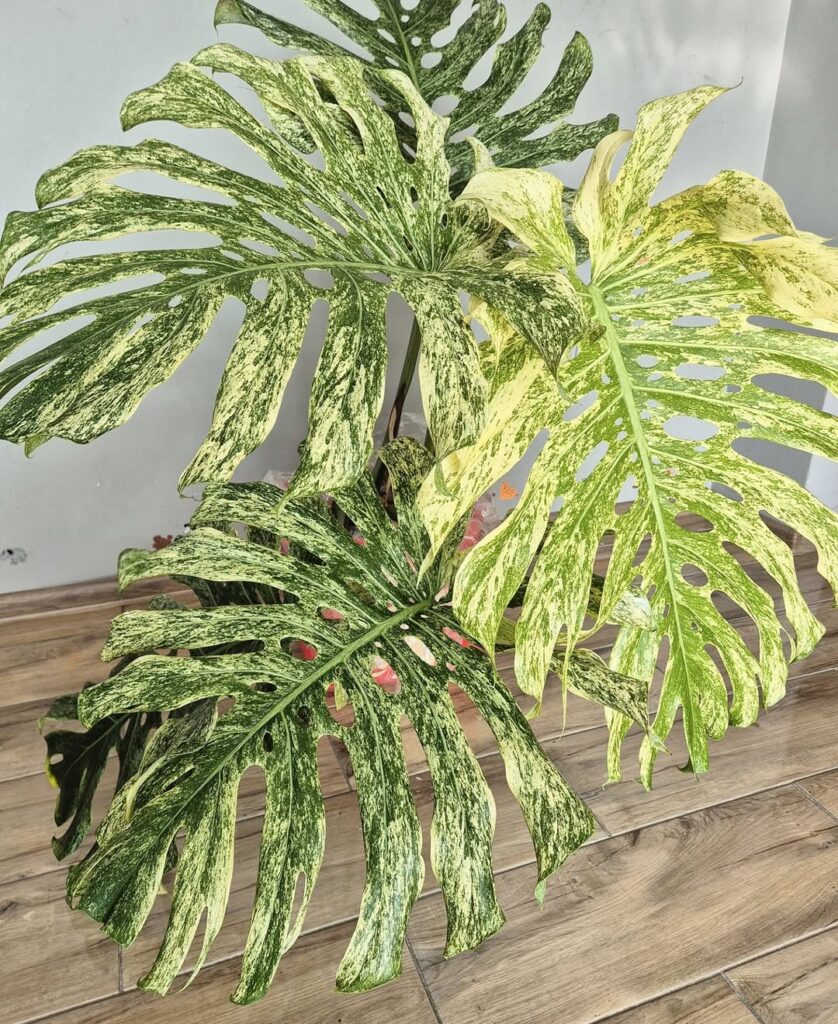
The Variegated Monstera Deliciosa is a highly sought-after mutation of the regular Monstera Deliciosa, featuring stunning white or cream-colored patches on its characteristic split leaves. This rare variation occurs due to a genetic mutation that affects chlorophyll production in parts of the plant tissue, creating unique patterns that make each leaf distinct. The variegation can appear as marbling, sectors, or half-moon patterns, with some leaves showing more dramatic coloring than others. Due to its reduced chlorophyll content, this variety grows more slowly than its non-variegated counterpart and requires more specific care to maintain its striking appearance.
- Light: Bright, indirect light; avoid direct sunlight which can burn leaves; morning sun is acceptable
- Water: Allow top 2-3 inches of soil to dry between waterings; reduce watering in winter
- Soil: Well-draining, airy mix with peat moss, perlite, and orchid bark
- Humidity: Minimum 60%; higher humidity promotes better growth
- Temperature: 65-85°F (18-29°C); protect from cold drafts
- Fertilizer: Balanced liquid fertilizer monthly during growing season
- Support: Moss pole or trellis for climbing
- Pot: Well-draining container with drainage holes
6. Black Velvet Alocasia
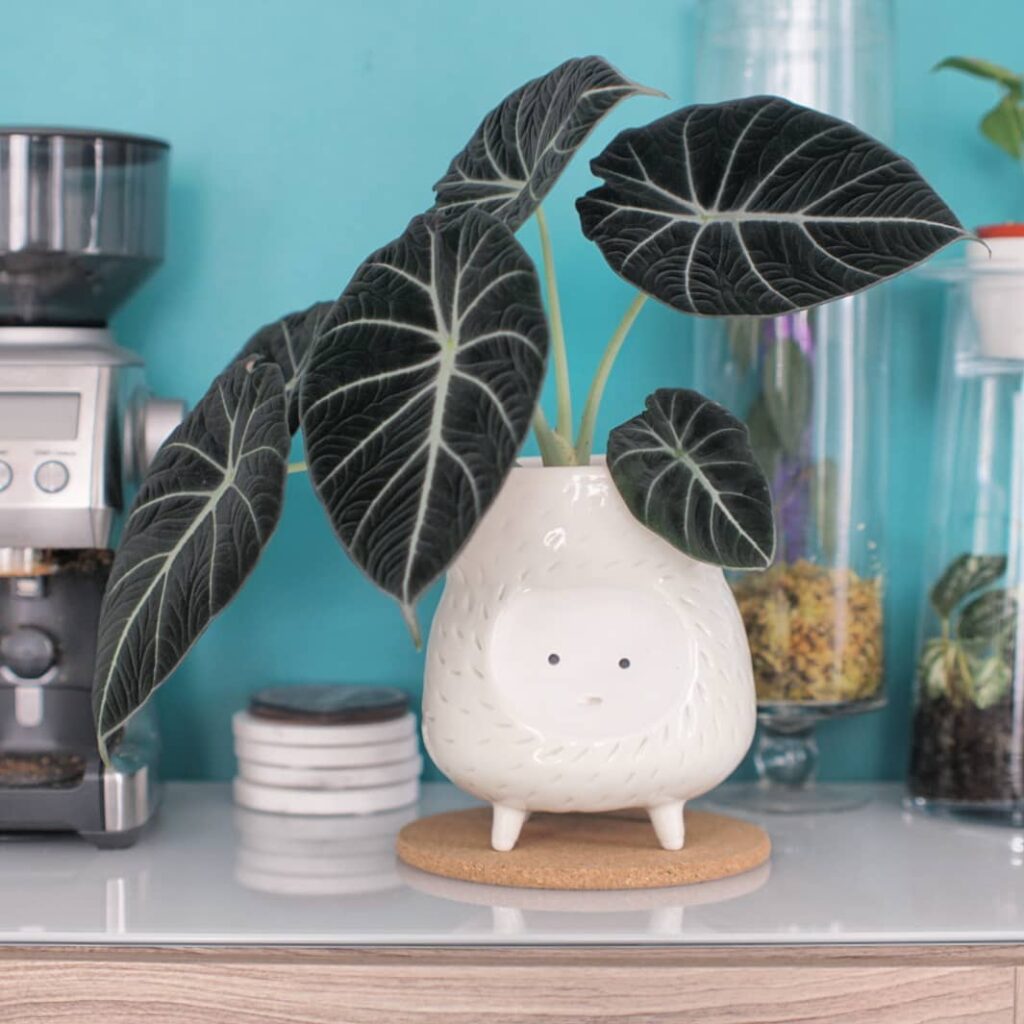
Black Velvet Alocasia (Alocasia reginula) is a striking dwarf variety of the Alocasia family, prized for its velvety, almost-black leaves with silvery-white veining. This compact plant typically grows to about 12 inches tall, making it perfect for small spaces. The heart-shaped leaves have a luxurious, touchable texture created by tiny, dense hairs that give the foliage its characteristic dark, matte appearance. Native to Borneo, this tropical plant has become highly sought-after among rare plant collectors for its unique appearance and manageable size.
- Light: Bright, indirect light; avoid direct sunlight which can burn leaves
- Water: Keep soil consistently moist but not waterlogged; water when top inch of soil feels dry
- Humidity: Requires high humidity (60% or higher)
- Temperature: Warm conditions between 65-85°F (18-29°C)
- Soil: Well-draining, airy potting mix rich in organic matter
- Fertilizer: Feed monthly during growing season with balanced liquid fertilizer
- Potting: Use containers with drainage holes; repot annually in spring
- Winter Care: Reduce watering and stop fertilizing during dormancy
8. Spiral Calathea Ornata
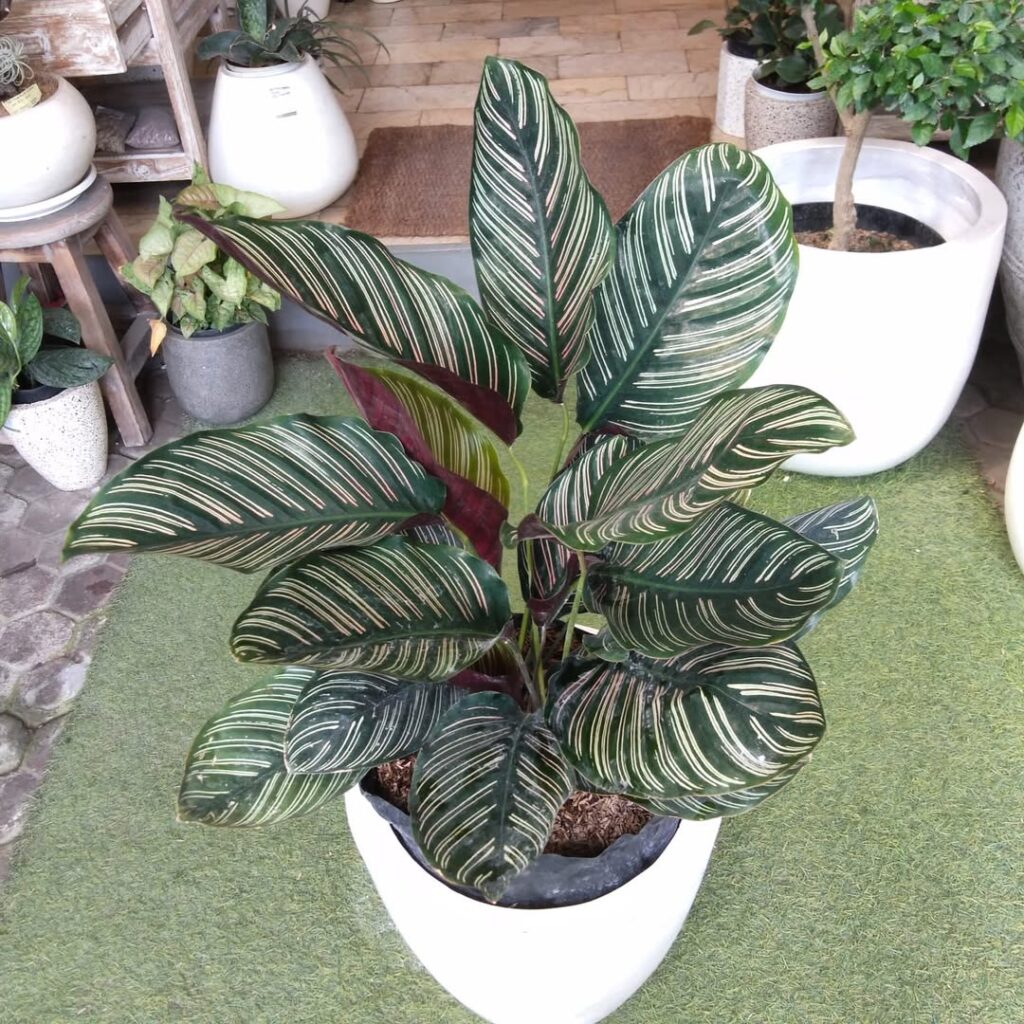
The Spiral Calathea Ornata, also known as Pinstripe Plant, is a striking tropical houseplant recognized for its distinctive spiral growth pattern and elegant pink or white pinstriped leaves. This rare variety of Calathea features elongated oval leaves that emerge tightly coiled and gradually unfurl in a mesmerizing spiral formation. The leaves display dramatic contrasts between dark green surfaces and delicate striping, while the undersides show a rich purple hue. As with other prayer plants, its leaves perform daily movements, folding upward at night and opening during the day.
- Light: Bright indirect light; avoid direct sunlight which can fade stripes and burn leaves
- Water: Keep soil consistently moist but not waterlogged; water when top inch of soil feels dry
- Humidity: High humidity (60-80%); use humidifier or pebble tray
- Temperature: 65-80°F (18-27°C)
- Soil: Well-draining, rich potting mix with peat moss and perlite
- Fertilizer: Monthly feeding during growing season with balanced liquid fertilizer
- pH: 6.0-6.5
- Repotting: Every 1-2 years in spring
- Special Care: Use filtered or distilled water; sensitive to chlorine and fluoride
9. Ponytail Palm
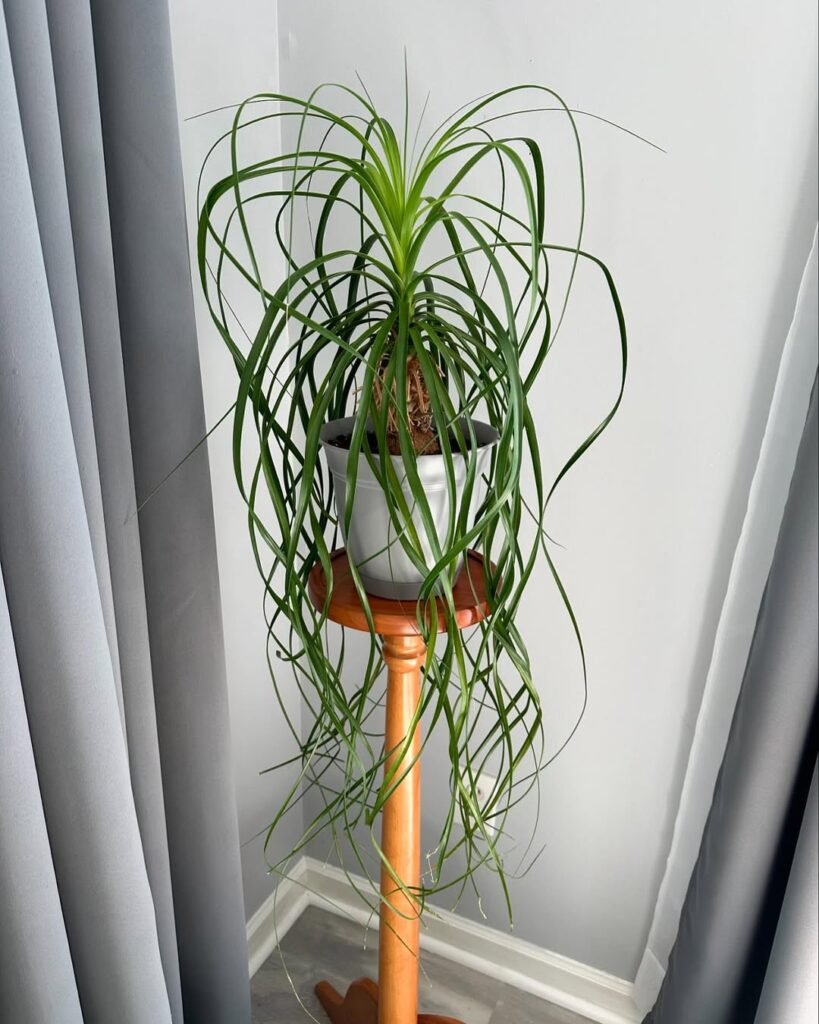
The Ponytail Palm (Beaucarnea recurvata) features a distinctive bulbous base that stores water and thin, long leaves that cascade like a fountain. Despite its common name, it’s not actually a palm but rather a member of the Asparagaceae family. This slow-growing succulent typically reaches only 2-3 feet in height, making it perfect for indoor spaces where its larger cousin wouldn’t fit. The swollen base, resembling an elephant’s foot, gives this plant its unique character and serves as a water reservoir.
- Light: Bright indirect light; can tolerate some direct sun; avoid deep shade
- Water: Allow soil to dry between waterings; water sparingly in winter
- Soil: Well-draining cactus or succulent mix
- Temperature: 60-80°F (15-27°C)
- Humidity: Tolerates average household humidity
- Fertilizer: Light feeding with balanced fertilizer during growing season
- Pot: Use containers with drainage holes; prefer being slightly root-bound
- Propagation: Mainly through seeds or offsets when available
10. Red Dragon Anthurium
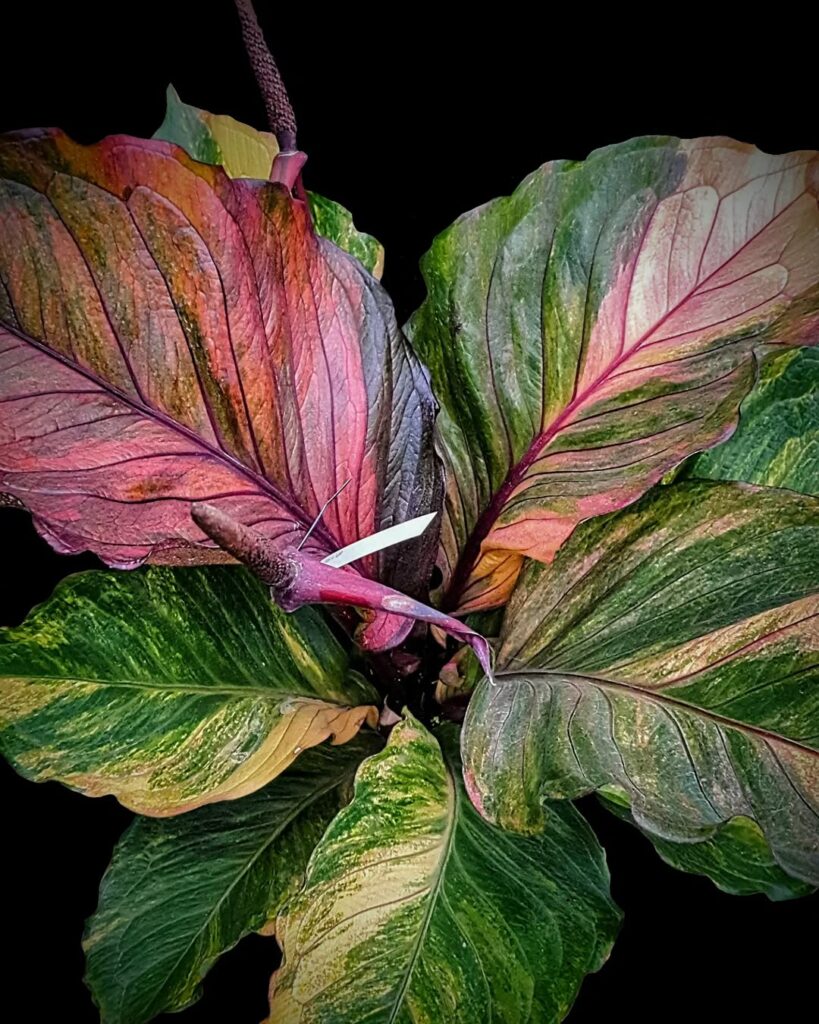
The Red Dragon Anthurium is a striking tropical plant known for its deep crimson, heart-shaped flowers and dark green foliage. This variety of Anthurium andraeanum stands out for its particularly vibrant red spathe and spadix combination, making it a popular choice among rare plant collectors. The flowers can bloom year-round under ideal conditions, and the plant typically grows to a height of 1-2 feet, making it suitable for indoor cultivation.
- Light: Bright, indirect light; protect from direct sunlight which can scorch leaves
- Water: Keep soil consistently moist but not waterlogged; water when top inch of soil feels dry
- Humidity: Requires high humidity (60-80%); use humidifier or pebble tray
- Temperature: Warm conditions between 65-85°F (18-29°C)
- Soil: Well-draining, airy mix of orchid bark, peat moss, and perlite
- Fertilizer: Feed monthly with balanced, water-soluble fertilizer during growing season
- Potting: Use containers with drainage holes; repot every 2-3 years
11. Persian Shield Plant

The Persian Shield (Strobilanthes dyerianus) is a stunning tropical plant known for its iridescent purple leaves with silvery metallic overtones. Native to Myanmar, this exotic houseplant features lance-shaped foliage with deep veining and can grow up to 4 feet tall indoors. Its eye-catching purple leaves are most vibrant when grown in ideal conditions, making it a dramatic accent piece in any indoor plant collection.
- Light: Bright, indirect light; morning sun is beneficial but protect from harsh afternoon rays
- Water: Keep soil consistently moist but not waterlogged; water when top inch of soil feels dry
- Humidity: High humidity (50% or higher); regular misting or use of humidity tray recommended
- Temperature: 60-75°F (15-24°C); protect from cold drafts
- Soil: Well-draining, rich potting mix with added organic matter
- Fertilizer: Feed monthly during growing season with balanced liquid fertilizer
- Pruning: Pinch back regularly to encourage bushier growth and maintain shape
13. Zebra Plant With Stripes
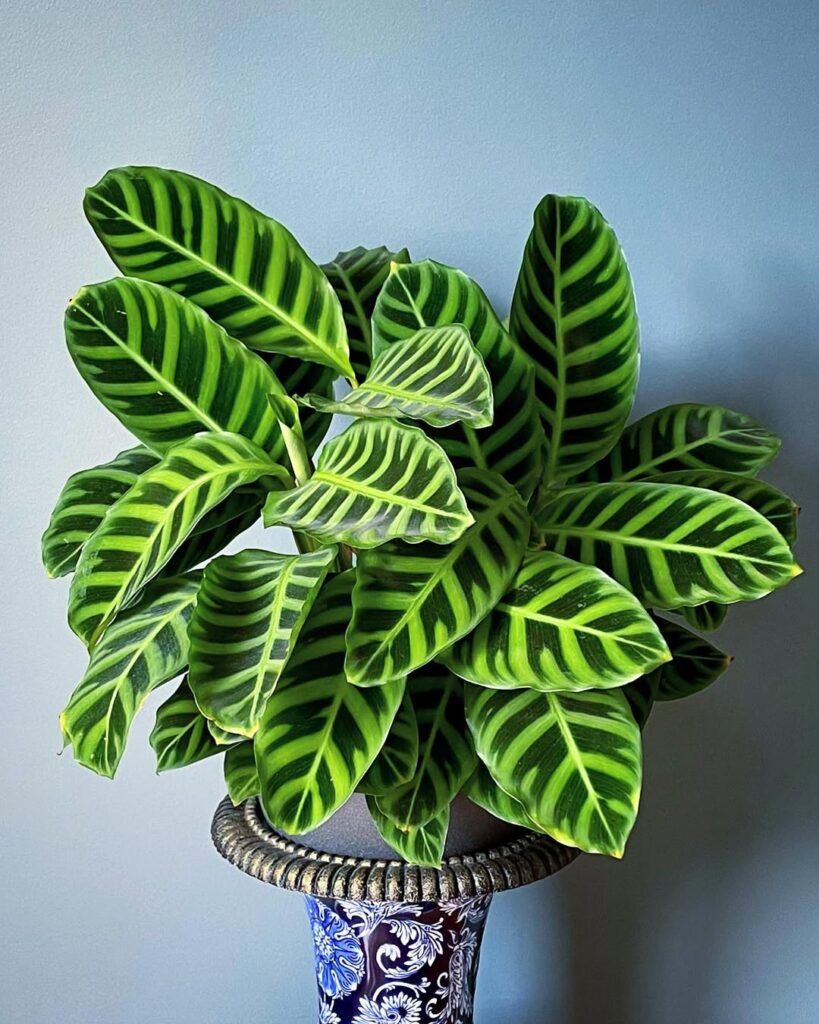
The Zebra Plant (Calathea zebrina) is a striking tropical houseplant known for its distinctive dark green leaves marked with pale green or whitish stripes that resemble zebra patterns. These velvety, elongated leaves can grow up to 40 centimeters long and emerge from the base of the plant on long stalks. The dramatic foliage moves throughout the day in response to light, lifting upward at night and lowering during daylight hours, a process known as nyctinasty.
- Light: Bright indirect light; avoid direct sunlight which can fade the stripes and burn leaves
- Water: Keep soil consistently moist but not waterlogged; water when top inch of soil feels dry
- Humidity: High humidity (60-70%); use humidifier or pebble tray with water
- Temperature: 65-75°F (18-24°C); protect from cold drafts
- Soil: Well-draining, rich potting mix with peat moss
- Fertilizer: Feed monthly during growing season with balanced liquid fertilizer
- pH: 6.0-6.5 (slightly acidic)
14. Crystal Anthurium
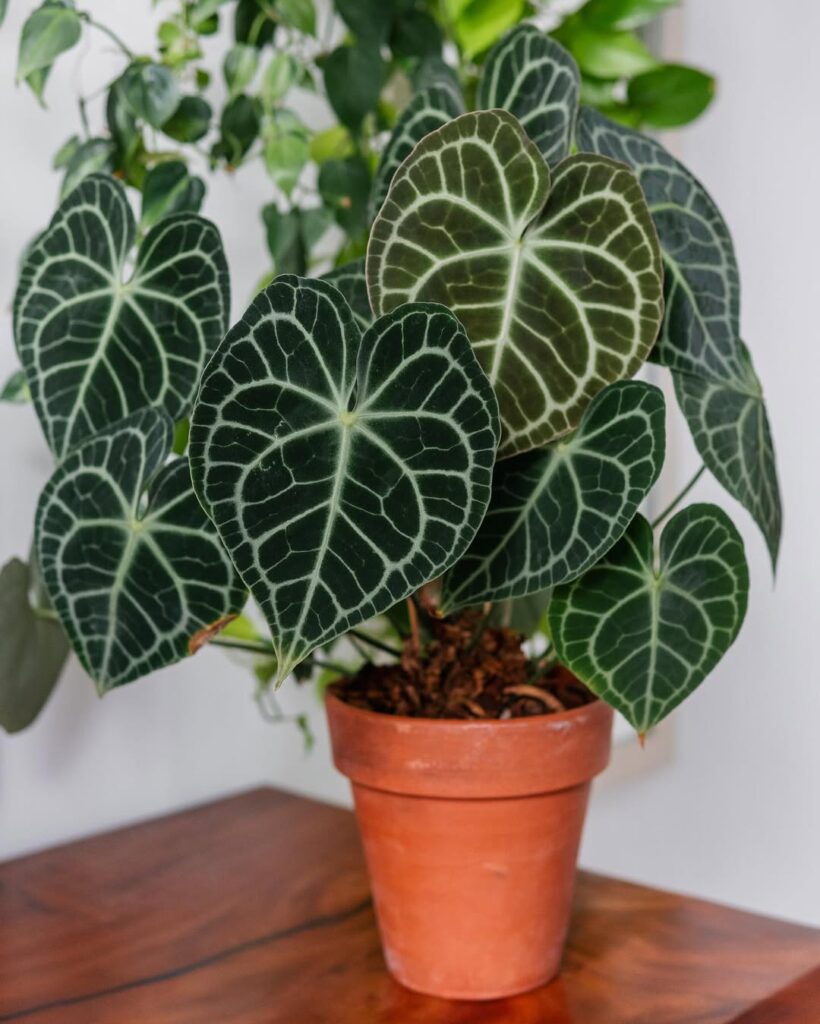
The Crystal Anthurium is a striking tropical plant known for its distinctive crystalline-looking foliage that appears almost translucent. As a member of the Araceae family, this rare variety features elongated, arrow-shaped leaves with a silvery-white, glass-like appearance that creates an ethereal effect. The leaves develop a subtle sheen and can show varying levels of transparency depending on light exposure, making it a highly sought-after collector’s plant.
- Light: Bright indirect light; avoid direct sunlight which can damage the delicate leaves
- Water: Keep soil consistently moist but not waterlogged; water when top 1-2 inches of soil feels dry
- Humidity: Requires high humidity levels (60-80%); use a humidifier or pebble tray
- Temperature: Warm conditions between 65-80°F (18-27°C)
- Soil: Well-draining, airy mix of orchid bark, peat moss, and perlite
- Fertilizer: Feed monthly during growing season with balanced liquid fertilizer diluted to half strength
- Container: Use pot with drainage holes to prevent root rot
- Position: Protected from drafts and air conditioning vents
15. Ruby Rubber Tree
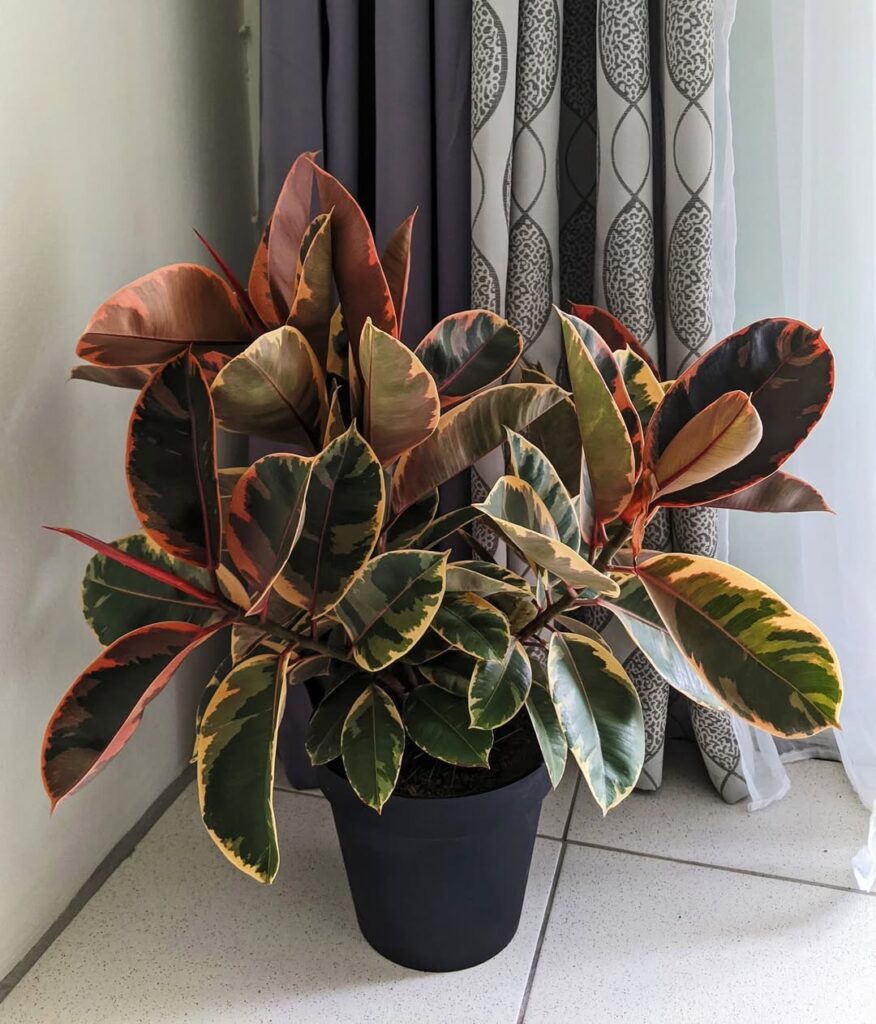
The Ruby Rubber Tree (Ficus elastica ‘Ruby’) is a striking variegated cultivar of the classic rubber plant, featuring dark green leaves with pink to cream-colored margins and stunning ruby-red undersides. This tropical plant can grow up to 6-8 feet tall indoors and develops thick, leathery leaves that emerge from pink sheaths. The unique coloration becomes more vibrant when the plant receives adequate light, making it a dramatic focal point in any indoor space.
- Light: Bright, indirect light; can tolerate some direct morning sun; protect from harsh afternoon sunlight to prevent leaf burn
- Water: Allow top 1-2 inches of soil to dry between waterings; reduce watering in winter
- Soil: Well-draining potting mix rich in organic matter
- Humidity: Moderate to high; mist regularly or use a humidity tray
- Temperature: 60-85°F (15-29°C); avoid cold drafts
- Fertilizer: Feed monthly during growing season with balanced liquid fertilizer
- Soil pH: 6.0-7.0
- Potting: Repot every 2-3 years or when rootbound
